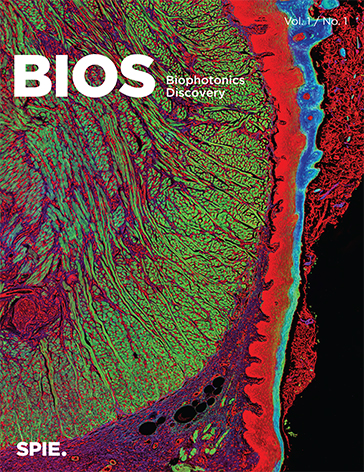Biophotonics Discovery (BIOS) addresses a gap in the current biophotonics publishing landscape. Many researchers in the biophotonics field are leveraging newly developed techniques to discover new biology and physiology, or to tackle important unmet clinical needs. This Gold Open Access journal will be the premier venue to highlight the realized promise of novel and emerging biophotonics technologies and their impacts on basic and clinical science and medicine. Read the press release.

Background
SPIE launched Biophotonics Discovery to provide a peer-reviewed outlet for the extensive range of innovative research presented at the Photonics West BiOS Symposium each year. The new journal will complement the Society’s other biomedical journals: Journal of Biomedical Optics (JBO), which focuses primarily on optical-device development, Journal of Medical Imaging (JMI), and Neurophotonics. Uniquely, Biophotonics Discovery will cover the entire breadth of the BiOS symposium’s topics, including the more application-specific conferences, which previously did not have a clear peer-reviewed journal outlet with SPIE.
The journal is open for submissions and expects to publish the first issue in early 2024.

Aims and Scope
The journal will publish high-quality works focused on basic and translational biophotonics. The emphasis of published work will be on what can be learned about biology, healthy physiology, and pathophysiology based on the unique capabilities of novel and emerging biophotonic techniques. Studies are expected to utilize biological samples: cells, tissues, and/or human in vivo measurements.
The journal will consider manuscripts that describe developments and use of a wide range of novel and emerging biophotonic techniques including microscopy, spectroscopy, imaging, biosensors, nanoscale optics, and contrast agents. This includes investigations that utilize data driven approaches and deep learning. Topics include:
- Basic discovery: Investigations of new biological observations in cells, organoids, animal models, or human tissue samples using emerging biophotonic technologies. This includes studies related to:
- disease states
- biomechanics
- wound healing
- developmental biology
- immunology, metabolism, cell death, and other biological phenomena
- Physiological monitoring: Investigations and advances of physiological signatures in humans and/or preclinical models, including studies related to:
- cardiac physiology (e.g., photoplethysmography, heart rate variability, SpO2, etc.).
- neuro signal processing (e.g., investigations of noninvasive measures of critical closing pressure)
- developments of biophotonic wearables, remote patient monitoring, and digital health
- biofluid measurements (e.g., total blood counts)
- sex differences
- optics of skin tone
- Clinical translation: Investigations that involve human measurements in the clinical setting. This includes the results of clinical studies addressing the following topics:
- diagnosis of disease
- molecularly guided surgery
- therapies and therapeutic monitoring
- endoscopy
- global health applications
- standardization needed for clinical adoption and commercialization.
The following papers are not within the scope of the journal:
- Works that focus solely on the development of the techniques and methods without a strong demonstration of basic science or clinical impact.
- Works that report on empirical measurements/observations without innovating in basic science, clinical discoveries, or applications, especially when non-customized commercial instruments are used.
Data Availability Policy
- At a minimum, tabulated data for all tables and figures in the paper need to be made publicly available at the time of publication. Read the journal's full Data Availability Policy.
Scientific Rigor
- Please see the journal guidelines for specific instructions. The items below briefly describe important aspects of the journal's policies on scientific rigor.
- For works focused on basic science: It is expected that authors will rigorously use validating biomarkers to support new optical observations.
- For works focused on clinical medicine and human subjects:
- It is expected that authors will rigorously use clinical biomarkers to validate new optical observations.
- It is expected that authors will present data on diverse patient populations that appropriately represent and address the factors of sex, race, and ethnicity.
- For all works:
- Authors are expected to utilize comprehensive and rigorous statistics to support claims.
- Authors are expected to provide a description of how they will make data available to other researchers at the time of publication.
- Authors are expected to disclose any conflicts of interest, including relevant intellectual property, business relationships, investments, and any other relevant commercial interests.
Details
ISSN: 3005-4745
Publisher: SPIE
Frequency: Quarterly (4 issues/year)
Year Established: 2023
Format: Online
Access: Biophotonics Discovery (BIOS) articles are published with immediate open access under a Creative Commons 4.0 Attribution (CC BY) license. The article publication charge (APC) is waived for all articles submitted through 2024.
Content Alerts
Sign up to receive publication alerts from BIOS journal.
Contact us
For questions about submitting to or publishing in BIOS, contact the journal staff at BIOS@spie.org.

